What Temperature Should a Greenhouse Be During the Day? Essential Tips for Optimal Plant Growth

Creating the ideal environment in a greenhouse is crucial for promoting healthy plant growth. One of the most significant factors influencing plant development is temperature, particularly during daylight hours. Understanding what temperature your greenhouse should maintain can lead to improved crop yields and robust plants. In this article, we will explore the optimal temperature range for daytime in a greenhouse, along with essential tips to achieve and maintain this environment. Whether you're a seasoned gardener or a beginner, this guide will help you ensure that your plants thrive by providing them with the best possible conditions.
Ideal Daytime Temperature for a Greenhouse
The ideal daytime temperature for a greenhouse typically ranges between 70°F to 80°F (approximately 21°C to 27°C), depending on the specific plants being grown. This temperature range promotes optimal growth and development, allowing for efficient photosynthesis and transpiration processes. However, it's essential to monitor the greenhouse's climate continuously because fluctuations can occur due to external weather conditions, and adjustments may be necessary to prevent heat stress or inadequate growing conditions for sensitive plants.
Factors Influencing Greenhouse Temperature
Several factors can influence the temperature inside a greenhouse, including the quality of the glazing material, ventilation systems, and shading mechanisms. The choice of glass or polycarbonate panels not only affects how much light enters the structure but also impacts heat retention. Proper ventilation allows excess heat to escape during the hottest parts of the day, while shading can protect plants from intense sunlight, contributing to maintaining the desired temperature range.
Importance of Monitoring Temperature
Regularly monitoring the temperature in a greenhouse is crucial for plant health. Using thermometers or climate control systems can help manage temperature fluctuations effectively. By keeping track of the internal environment, growers can make informed decisions regarding ventilation and heating systems, ensuring that plants are not exposed to conditions that could hinder their growth or lead to stress.
Day vs. Night Temperature Variations
It's important to recognize that the ideal temperature range for a greenhouse is typically different during the day than at night. During the day, the temperature ideally should be kept warm enough to support photosynthesis, while at night, the temperature can drop to about 60°F to 70°F (approximately 15°C to 21°C) to allow for restful growth conditions. These variations help create an environment that mimics the natural cycle of plant growth.
See also:
Seasonal Temperature Adjustments
As seasons change, so should the temperature management strategies in a greenhouse. In winter, heating systems may be necessary to maintain optimal temperatures, while during the summer, shading and increased ventilation may be required to prevent overheating. Adapting to seasonal changes not only ensures consistent plant health but also maximizes growth potential throughout the year.
Plants and Their Ideal Temperature Ranges
Different plants have unique temperature requirements; for instance, tropical plants thrive in warmer conditions, while cool-season crops prefer lower daytime temperatures. Understanding the specific needs of the plants you are growing is vital. For example, some vegetables like lettuce prefer temperatures around 65°F (approximately 18°C), whereas tomatoes may flourish at higher temperatures of around 75°F (approximately 24°C).
| Plant Type | Ideal Daytime Temperature |
|---|---|
| Lettuce | 65°F (18°C) |
| Tomatoes | 75°F (24°C) |
| Peppers | 70°F - 85°F (21°C - 29°C) |
| Herbs | 60°F - 75°F (15°C - 24°C) |
| Orchids | 70°F - 80°F (21°C - 27°C) |
Understanding the Ideal Temperature Range for Different Plants
The ideal temperature for a greenhouse during the day typically ranges between 70°F to 80°F (21°C to 27°C), depending on the plant species being grown. It is crucial to maintain this range as it directly influences photosynthesis, growth rates, and overall plant health. Understanding specific temperature requirements for various plants helps to optimize conditions for their development. For instance, tropical plants thrive in warmer temperatures, whereas cool-season crops prefer slightly cooler conditions. Proper ventilation, shade cloths, and heating systems can help achieve these ideal temperatures, ensuring that plants receive the best possible environment for their growth.
Factors Affecting Greenhouse Temperature
Several factors can influence greenhouse temperature, including solar radiation, ventilation, and humidity levels. On sunny days, natural sunlight can significantly raise the temperature inside a greenhouse, potentially exceeding optimal levels if not properly managed. Adequate ventilation is essential to allow for air exchange, while maintaining humidity ensures the plants remain hydrated and reduces stress from excessive heat. Monitoring these factors and making adjustments can help maintain a stable internal climate conducive to plant growth.
The Role of Ventilation in Temperature Control
Ventilation plays a critical role in controlling greenhouse temperatures. Proper airflow can help prevent overheating, particularly on hot days. Installing vents in the roof and sides of the greenhouse allows hot air to escape while drawing in cooler air from outside. Automated systems can efficiently open and close vents based on temperature readings, ensuring a consistent and comfortable environment for plants. Additionally, good ventilation helps reduce the risk of disease and pests by maintaining airflow, which is essential for plant health.
See also:
Using Shade Cloths to Regulate Temperature
Shade cloths are an effective way to manage greenhouse temperatures, particularly during the hottest months. These cloths reduce the amount of direct sunlight that enters the greenhouse, thus lowering the internal temperature. Available in various shadings, choosing the appropriate percentage can help protect sensitive plants from scorching while still allowing enough light for photosynthesis. Utilizing shade cloths in conjunction with other cooling measures, such as fans, can significantly improve the internal climate, promoting optimal growth conditions.
Heating Solutions for Cooler Weather
In cooler climates or during the winter months, maintaining the ideal temperature in a greenhouse may require additional heating solutions. Options such as electric heaters, gas heaters, or propane heaters can provide the necessary warmth to keep temperatures within the ideal range. It’s important to monitor temperatures closely and adjust heating solutions as necessary to prevent overheating or underheating, which can negatively impact plant health. Implementing a thermostat can help automate this process, ensuring a stable environment regardless of outside conditions.
Optimal Temperature for Specific Plant Types
Different plant species have varying temperature requirements. For example, warm-season crops like tomatoes and peppers flourish best in temperatures around 75°F to 85°F (24°C to 29°C), while cool-season crops such as lettuce and spinach prefer cooler temperatures, around 60°F to 70°F (15°C to 21°C). Understanding these specific needs allows greenhouse owners to tailor their climate control strategies effectively. By grouping plants with similar temperature requirements together, it can help optimize the growing environment and improve overall productivity.
Questions from Our Readers
What is the ideal daytime temperature for a greenhouse?
The ideal daytime temperature for a greenhouse typically ranges between 75°F to 85°F (24°C to 29°C). Maintaining this range helps to promote optimal plant growth while ensuring that the plants are not subjected to heat stress.
How can I maintain the temperature in my greenhouse during the day?
To maintain the temperature in your greenhouse during the day, you can utilize ventilation systems, shade cloths, and fans. These methods allow for proper air circulation and help prevent excessive heat buildup, especially during hot summer months.
See also:
What factors can affect the temperature in a greenhouse during the day?
Several factors can affect the temperature in a greenhouse during the day, including sunlight exposure, geographic location, and the materials used for construction. Additionally, the greenhouse's insulation and the number of plants inside can also play a significant role in temperature regulation.
What should I do if my greenhouse gets too hot during the day?
If your greenhouse gets too hot during the day, you can employ measures such as increasing ventilation, using shade cloths, or even installing a misting system to cool down the environment. Implementing these strategies helps to protect your plants from damage caused by extreme heat conditions.

If you want to read more articles like What Temperature Should a Greenhouse Be During the Day? Essential Tips for Optimal Plant Growth, we recommend you check out our Greenhouse category.
Leave a Reply
Related Articles